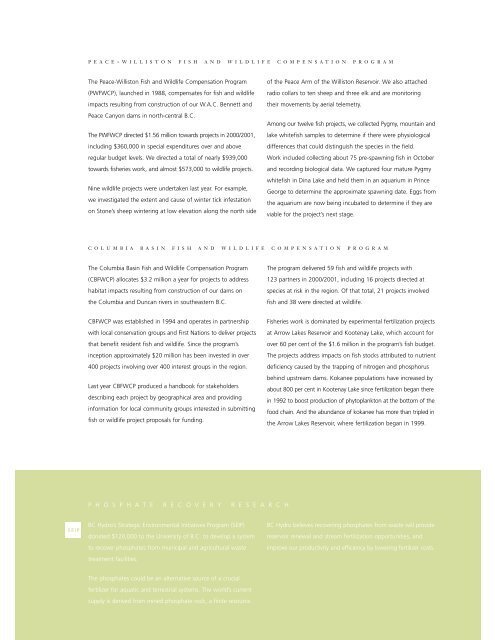2001 Triple Bottom Line Report - BC Hydro
2001 Triple Bottom Line Report - BC Hydro
2001 Triple Bottom Line Report - BC Hydro
You also want an ePaper? Increase the reach of your titles
YUMPU automatically turns print PDFs into web optimized ePapers that Google loves.
SEIP<br />
P E A C E- W I L L I S T O N F I S H A N D W I L D L I F E C O M P E N S A T I O N P R O G R A M<br />
The Peace-Williston Fish and Wildlife Compensation Program<br />
(PWFWCP), launched in 1988, compensates for fish and wildlife<br />
impacts resulting from construction of our W.A.C. Bennett and<br />
Peace Canyon dams in north-central B.C.<br />
The PWFWCP directed $1.56 million towards projects in 2000/<strong>2001</strong>,<br />
including $360,000 in special expenditures over and above<br />
regular budget levels. We directed a total of nearly $939,000<br />
towards fisheries work, and almost $573,000 to wildlife projects.<br />
Nine wildlife projects were undertaken last year. For example,<br />
we investigated the extent and cause of winter tick infestation<br />
on Stone’s sheep wintering at low elevation along the north side<br />
E N V I R O N M E N T A L B O T T O M L I N E | 9<br />
of the Peace Arm of the Williston Reservoir. We also attached<br />
radio collars to ten sheep and three elk and are monitoring<br />
their movements by aerial telemetry.<br />
Among our twelve fish projects, we collected Pygmy, mountain and<br />
lake whitefish samples to determine if there were physiological<br />
differences that could distinguish the species in the field.<br />
Work included collecting about 75 pre-spawning fish in October<br />
and recording biological data. We captured four mature Pygmy<br />
whitefish in Dina Lake and held them in an aquarium in Prince<br />
George to determine the approximate spawning date. Eggs from<br />
the aquarium are now being incubated to determine if they are<br />
viable for the project’s next stage.<br />
C O L U M B I A B A S I N F I S H A N D W I L D L I F E C O M P E N S A T I O N P R O G R A M<br />
The Columbia Basin Fish and Wildlife Compensation Program<br />
(CBFWCP) allocates $3.2 million a year for projects to address<br />
habitat impacts resulting from construction of our dams on<br />
the Columbia and Duncan rivers in southeastern B.C.<br />
CBFWCP was established in 1994 and operates in partnership<br />
with local conservation groups and First Nations to deliver projects<br />
that benefit resident fish and wildlife. Since the program’s<br />
inception approximately $20 million has been invested in over<br />
400 projects involving over 400 interest groups in the region.<br />
Last year CBFWCP produced a handbook for stakeholders<br />
describing each project by geographical area and providing<br />
information for local community groups interested in submitting<br />
fish or wildlife project proposals for funding.<br />
P H O S P H A T E R E C O V E R Y R E S E A R C H<br />
<strong>BC</strong> <strong>Hydro</strong>’s Strategic Environmental Initiatives Program (SEIP)<br />
donated $120,000 to the University of B.C. to develop a system<br />
to recover phosphates from municipal and agricultural waste<br />
treatment facilities.<br />
The phosphates could be an alternative source of a crucial<br />
fertilizer for aquatic and terrestrial systems. The world’s current<br />
supply is derived from mined phosphate rock, a finite resource.<br />
The program delivered 59 fish and wildlife projects with<br />
123 partners in 2000/<strong>2001</strong>, including 16 projects directed at<br />
species at risk in the region. Of that total, 21 projects involved<br />
fish and 38 were directed at wildlife.<br />
Fisheries work is dominated by experimental fertilization projects<br />
at Arrow Lakes Reservoir and Kootenay Lake, which account for<br />
over 60 per cent of the $1.6 million in the program’s fish budget.<br />
The projects address impacts on fish stocks attributed to nutrient<br />
deficiency caused by the trapping of nitrogen and phosphorus<br />
behind upstream dams. Kokanee populations have increased by<br />
about 800 per cent in Kootenay Lake since fertilization began there<br />
in 1992 to boost production of phytoplankton at the bottom of the<br />
food chain. And the abundance of kokanee has more than tripled in<br />
the Arrow Lakes Reservoir, where fertilization began in 1999.<br />
<strong>BC</strong> <strong>Hydro</strong> believes recovering phosphates from waste will provide<br />
reservoir renewal and stream fertilization opportunities, and<br />
improve our productivity and efficiency by lowering fertilizer costs.
















